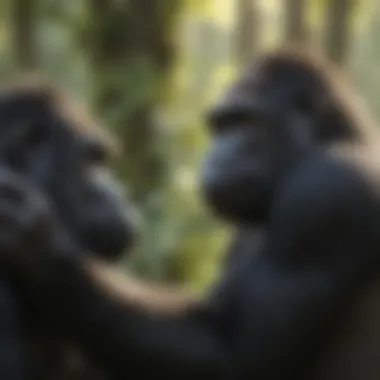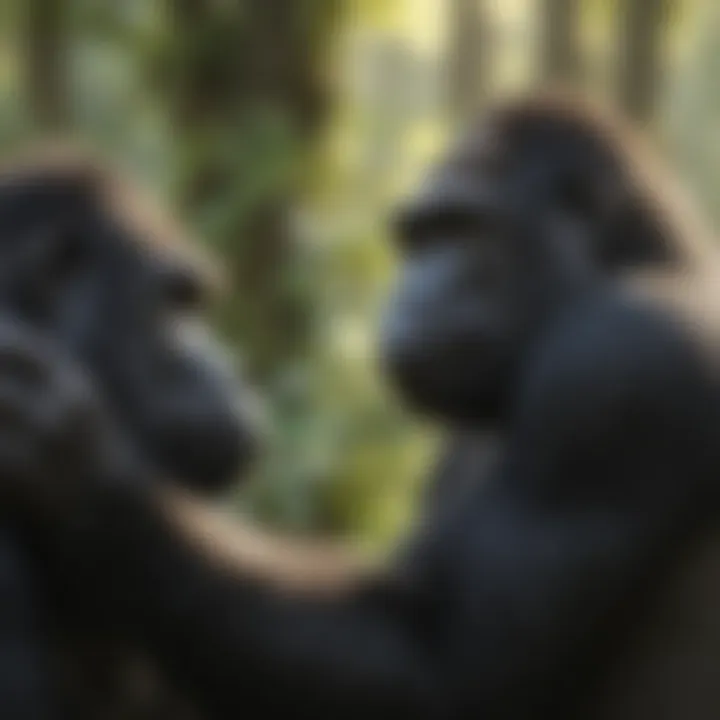Intriguing Insights: Fun Facts About Gorillas


Nature Topic Overview
Gorillas are remarkable creatures that share many traits with humans, making them one of our closest relatives in the animal kingdom. These primates are often seen as gentle giants, though they have a complex social structure and behaviors that are fascinating to explore. Understanding gorillas is essential for appreciating their role in the ecosystem and the challenges they face due to habitat loss and poaching. By learning about these incredible beings, young readers can grasp their importance and feel inspired to protect them.
Fun Facts and Trivia
Gorillas are known for several fun and interesting facts that can captivate the imagination of children:
- Size and Strength: Adult male gorillas can weigh between 300 to 500 pounds and can stand over six feet tall. Despite their size, they are mostly gentle.
- Social Structure: Gorillas typically live in groups called troops. These troops are led by a dominant male known as a silverback.
- Communication: Gorillas communicate through a variety of sounds, gestures, and facial expressions. They can even learn sign language!
- Diet: Gorillas are herbivores. They eat primarily leaves, stems, and fruits.
Visuals can include images of gorillas in their natural habitat, as well as diagrams showing their communication methods.
Wildlife Explorations
Gorillas inhabit tropical forests, primarily in Africa. There are two main species of gorillas: the Western gorilla and the Eastern gorilla. Each species is further divided into subspecies. Some interesting facts include:
- Western Gorilla: This includes the Western Lowland gorilla, which is the most populous subspecies. They are known for their diverse diet and adaptability to different environments.
- Eastern Gorilla: This group includes the critically endangered Mountain gorilla. They are known to live in mountainous regions and have thicker fur for warmth.
Children could enjoy interactive quizzes about gorillas and their habitats, reinforcing what they've learned.
Environmental Awareness
Conservation of gorillas is crucial because their populations have plummeted in recent years. Understanding the significance of protecting gorillas leads to greater awareness about broader environmental issues. Here are some ways children can help:
- Reduce Waste: Use reusable bottles and bags to decrease plastic waste.
- Support Conservation Organizations: Learn about groups that work directly to help gorillas, such as the Dian Fossey Gorilla Fund.
- Spread Awareness: Share the knowledge about gorillas with friends and family.
"Every endangered species, including gorillas, plays a vital role in its ecosystem."
DIY Nature Activities
Here are some fun and educational activities for kids to engage with:
- Gorilla Masks: Create your own gorilla mask using paper plates, colors, and scissors. This activity helps children express their creativity.
- Nature Walk: Organize a walk in a local park to observe wildlife. Encourage children to take notes on the animals and plants they see, fostering curiosity about nature.
- Plant a Tree: Trees are essential for the environment. Kids can plant a tree with the help of parents and learn how trees benefit gorillas and other wildlife.
Engaging with nature through these activities reinforces the importance of conservation and encourages a deeper connection with wildlife.
Foreword to Gorillas
Gorillas are fascinating creatures that hold significant importance in our ecosystem. Understanding them is crucial, not only for appreciating their unique attributes but also for recognizing their role in nature. Gorillas are the largest primates on Earth and share close genetic ties with humans, offering insights into our own evolution, behavior, and social structures.
Moreover, gorillas contribute to maintaining the health of their habitats. As herbivores, they aid in seed dispersal, which promotes forest growth. This makes gorillas essential players in their environments, affecting plant life and other animal species. Knowing about gorillas can inspire conservation efforts and enhance awareness about biodiversity — a key value for readers of all ages.
The Importance of Gorillas in Nature
Gorillas play an important role in their ecosystems which many may not be aware. They support the growth of forests by consuming vast amounts of vegetation. This consumption helps regulate plant populations and provides space for new growth. Their roles extend beyond their immediate surroundings, influencing various species that depend on forest ecosystems for survival.
Additionally, gorillas can serve as indicators of environmental health. When gorilla populations are stable, it often means their habitat is thriving. On the other hand, a decline in their numbers can point to critical threats like habitat destruction or disease. This demonstrates how vital gorillas are in maintaining biodiversity.
Understanding Different Gorilla Species
Gorillas are categorized into several species, each with interesting traits. There are mainly two types: the Western Gorilla and the Eastern Gorilla, with each having distinct subspecies.
Western Gorilla
The Western Gorilla includes two subspecies: the Western Lowland Gorilla and the Cross River Gorilla. This gorilla is known for its adaptability, living in various habitats including both forests and swamps. Their social structures are fascinating as well, often forming troops led by a silverback male who manages interactions and conflicts.
A key feature of Western Gorillas is their smaller size compared to the Eastern counterparts. This may benefit them since they can maneuver better in their varied habitats. Their populations, however, are threatened due to poaching and habitat loss, making awareness crucial in conservation efforts.
Eastern Gorilla
The Eastern Gorilla is comprised of two subspecies: the Eastern Lowland Gorilla and the Mountain Gorilla. This species is often larger and more robust than its Western relatives. Mountain Gorillas inhabit high altitudes and are known for their thick fur, which keeps them warm in chilly environments.
Their unique adaptation to high altitudes illustrates the diversity of gorillas. However, they face significant conservation challenges, primarily due to limited habitats and human activity. Understanding Eastern Gorillas can help drive conservation initiatives, making them an important choice to discuss in this article.
Mountain Gorilla


Mountain Gorillas specifically capture attention due to their remarkable stories of survival. Found primarily in the Virunga Mountains, these gorillas have shown resilience against threats like poaching and habitat encroachment. Their strong family bonds within troops showcase complex social interactions that deepen our understanding of gorilla societies.
Mountain Gorillas are often a symbol of conservation success, with programs helping to increase their population through responsible tourism and protection measures. Their struggle for survival represents both a challenge and a hope for gorilla conservation, making it essential to highlight their plight in this article.
In summary, each gorilla species offers unique insights into their lives and their environments. Their presence affects biodiversity, and understanding this can help inspire future conservation efforts.
Gorilla Anatomy and Physiology
Gorilla anatomy and physiology are crucial elements of their overall biology. Understanding this aspect helps us appreciate their adaptations and behaviors. Gorillas possess unique physical features that not only define their physical appearance but also support their life in various environments. Recognizing these anatomical and physiological traits can enhance our knowledge about their health, behavior, and social structures.
Physical Characteristics
Size and Weight
The size and weight of gorillas are significant when discussing their biology. Gorillas are the largest living primates, with adult males averaging about 390 pounds and reaching heights of 5 to 6 feet. This immense size offers benefits like enhanced stability and a formidable presence in their habitats. One key characteristic of their weight is the muscle mass that contributes to their strength. Gorillas have a stocky build with broad shoulders and muscular limbs. This structure allows them to navigate their forest homes effectively and assert dominance within their troops.
A unique feature of their size is how it aids in thermoregulation. Gorillas thrive in both highland and lowland environments. Their substantial mass helps them retain heat during colder conditions, which is vital for survival. However, there are challenges associated with their size, particularly when it comes to agility. While they may not be as quick as smaller primates, their size compensates with raw power.
Strength and Dexterity
Strength and dexterity play vital roles in a gorilla's life. They are recognized for their impressive physical ability. Adult male gorillas can lift over 1,800 pounds, which far surpasses the strength of an average human. This strength is essential for a variety of activities, including climbing, foraging, and defending their troop against threats. It positions them as dominant beings within their ecosystem.
Moreover, gorillas have remarkable dexterity, particularly in their hands. Their ability to manipulate objects helps them forage efficiently. Gorillas use their long arms and strong hands to reach for high leaves and fruits. A distinctive feature is their opposable thumbs, which allow for precise gripping and holding of various food items. However, such dexterity may sometimes be viewed as a disadvantage when compared to the speed of smaller species. Yet, it remains vital for their dietary needs and social interactions.
Vision and Hearing
Vision and hearing are also important aspects of gorilla physiology. Gorillas have keen eyesight that can adapt to various lighting conditions in their forest habitats. They can see well in low light, which assists them in locating food during the early morning or late evening. Their eyesight contributes to social interactions, allowing them to read subtle cues from fellow gorillas.
On the other hand, gorillas demonstrate a well-developed sense of hearing. They can detect a wide range of frequencies, facilitating communication within their troops. This skill helps them respond to potential dangers in their environment. Understanding these senses allows insight into their social dynamics and survival strategies.
"Gorilla anatomy goes beyond just size and strength; it encompasses the intricate details of their senses that promote survival in the wild."
In summary, the anatomy and physiology of gorillas provide essential insight into their lives. From the massive size that impacts their interactions to the sensory adaptations aiding survival, every aspect plays a role. Understanding these features enriches our appreciation of gorillas in nature.
Gorilla Behavior
Understanding gorilla behavior is essential for grasping the full picture of these fascinating creatures. Gorillas exhibit complex social interactions and routines that reflect their adaptability in the wild. This knowledge can foster a deeper appreciation among young readers and educate parents and educators on the nuances of gorilla life. Exploring their social structures, daily activities, and communication methods reveals how gorillas thrive in their environments and helps emphasize their ecological significance.
Social Structure of Gorilla Troops
Gorilla troops are highly structured social groups, typically led by a dominant male known as a silverback. This hierarchy is crucial to the functioning and stability of the troop. Gorillas maintain peace and order within their group through dominance hierarchies, which fosters cooperation among members.
Dominance Hierarchies
The dominance hierarchies in gorilla troops play a significant role in maintaining social order. The silverback asserts authority over the group, which aids in protecting the troop from external threats. This protective aspect is one of the key characteristics of dominance hierarchies. It enables safer living conditions for all members. Another unique feature of this structure is that it reduces conflict among the adult males in the group. Generally, the dominant male tends to be larger and more experienced, giving him an advantageous position.
However, this hierarchy does have its challenges. For instance, younger males may feel pressured to challenge the silverback for leadership, which can sometimes lead to conflict. Thus, while beneficial for social cohesion, it also introduces a level of competition that can be detrimental.
Parental Roles
Parental roles are vital within gorilla troops and significantly influence the growth and development of young gorillas. Mothers are primarily responsible for childcare. They nurture their young with care, teaching them essential skills for survival. This nurturing aspect is a prominent characteristic of parental roles in gorillas.
This focus on maternal care is beneficial for the development of social skills in young gorillas. For example, mothers teach their offsprings how to communicate, forage, and interact with other troop members. A unique feature of this parenting style is the extended nurturing period. Young gorillas often stay with their mothers for several years, which enables them to learn through observation. However, this extended dependency can also be a disadvantage if environmental factors reduce resources.
Daily Activities and Routines
Daily activities in a gorilla's life are largely dictated by the rhythm of their habitat and social structure. Gorillas are primarily diurnal, meaning they are active during daylight hours. They spend a significant portion of their day foraging for food – around 30 percent of it.
Moreover, play is an essential part of their daily routine, especially among younger gorillas. Engaging in play serves not only to develop physical skills but also to strengthen social bonds within the troop. As a result, daily activities are not just about survival; they also play a large role in social development. In summary, gorilla behavior is complex and serves many critical functions that benefit individuals and the troop as a whole.
Communication Among Gorillas
Communication is a crucial aspect of gorilla life. It allows them to maintain social bonds within their groups, express their needs, and respond to their surroundings. Understanding how gorillas communicate can enhance our appreciation for these remarkable creatures and their complex societies. Communication takes many forms, including vocalizations, body language, and gestures. Each type plays a significant role in how gorillas interact with one another.
Vocalizations and Sounds


Gorillas use a variety of vocalizations to convey different messages. These sounds can range from low grunts to high-pitched hoots. Vocalizations serve multiple purposes:
- Warning: A deep roar may indicate danger, signaling others to stay alert.
- Communication: Soft grunts or barks can express contentment or anxiety.
- Appeal: Mothers make specific sounds to attract the attention of their young.
Interestingly, these vocalizations can vary between different species of gorillas. For instance, Mountain Gorillas might use sounds differently compared to Western Gorillas. The context of the vocalization often dictates its meaning. Observers of gorilla behavior note that a loud call in one instance could be playful, while the same sound in another situation could signal distress.
Body Language and Gestures
Besides vocal sounds, gorillas communicate effectively through body language and gestures. These non-verbal signals are essential, as they convey information about social hierarchies and emotions. For example:
- Posture: A relaxed stance might signify calmness, while a tense posture could suggest aggression or fear.
- Facial Expressions: A gorilla showing its teeth may not be smiling but rather displaying a defensive gesture.
- Gestures: Gorillas may extend a hand to indicate a desire for closeness or companionship.
Understanding these signs is foundational to interpreting gorilla behavior. Body language reflects their emotional state and social interactions. The subtlety and complexity of these signals illustrate how intelligent and sensitive these animals are.
"Gorillas are not just strong; they also possess a rich language of sounds and movements that reveal their emotional life."
This intricate system of communication underscores the depth of gorilla societies. By appreciating their communication methods, we can foster better conservation efforts and facilitate empathy for gorillas in their natural habitats. Understanding gorillas keeps alive the hope for their future.
Diet and Feeding Habits
Gorillas are primarily herbivorous, meaning their diet mainly consists of plant material. Understanding the diet and feeding habits of gorillas is essential for appreciating their role in the ecosystem. It also highlights their nutritional needs and how these needs affect their health and behavior. By exploring what gorillas eat and how they find their food, we can learn more about these fascinating creatures.
Herbivorous Diet
Gorillas consume a variety of plant-based foods including leaves, stems, fruits, and flowers. This diverse diet is crucial for their health.
Types of Food Consumed
The types of food gorillas eat are rich in nutrients. Gorillas especially favor leafy greens and the young shoots of plants. This is important because these foods support their large body size and energy levels.
- Common types include:
- Leaves
- Barks
- Fruits
These foods are not just filling; they are packed with vitamins important for gorilla health. However, the availability of these foods can vary by season, which influences their foraging behavior and social structure.
Foraging Behavior
Foraging behavior in gorillas is fascinating and important. They spend a significant part of the day searching for food. This behavior ensures they consume enough calories and nutrients.
- Key habits in foraging:
- Walking long distances to find food.
- Using their strong hands to strip leaves from branches.
Gorillas are known to communicate with each other during foraging, helping to find more food efficiently. The social aspect of foraging adds another layer to their behavior, enhancing group bonds.
Importance of Diet to Health
The diet of gorillas impacts their overall health significantly. A balanced intake of nutrients supports their immune systems and helps them maintain their enormous strength. Proper nutrition also plays a role in their reproductive health and longevity.
Gorilla Habitats
Gorilla habitats are critical to understanding the life and behavior of these primates. This section provides insight not only into where gorillas live, but also highlights how their environments shape their day-to-day activities and overall survival. Gorillas are mostly found in tropical and subtropical forests, where they navigate dense vegetation and steep terrains. The primary areas where gorillas inhabit are located in Africa, mainly in regions like the Democratic Republic of Congo, Uganda, and Rwanda. Each type of habitat has unique features that affect food availability and social interactions among gorillas. Understanding these habitats is crucial for conservation efforts, as they directly impact gorillas' health and continuation as a species.
Natural Habitats of Gorillas
Gorillas thrive in distinct natural habitats, primarily forested regions. There are different ecosystem types where gorillas are found, including:
- Lowland Rainforests: These areas are rich in biodiversity, providing ample foliage and fruits that are essential for gorilla diets.
- Mountainous Regions: For instance, mountain gorillas reside in elevated forests with cooler temperatures. These habitats require gorillas to adapt to more challenging weather conditions.
Gorillas play a vital role in their ecosystems. Their feeding habits help in seed dispersal, promoting plant growth. Additionally, they create pathways through dense vegetation, which benefits other animals. Their presence in these natural habitats also supports the intricate balance of life within the ecosystem, making conservation efforts pivotal.
Impact of Habitat Loss
The loss of habitats poses a significant threat to gorilla populations. Key factors that contribute to habitat degradation include:


- Deforestation: Logging and agricultural expansion lead to loss of forest cover, which disrupts gorilla food sources and living spaces.
- Human Encroachment: Expansion of urban areas and roads fragment gorilla habitats, isolating troops and making it harder for them to find mates.
According to a report by the World Wildlife Fund, about 50% of gorilla habitats have been lost in the past few decades due to human activities.
The decrease in their natural habitats forces gorillas into smaller areas, increasing competition for resources. This can result in stress and reduced reproductive success. Conservation initiatives aim to protect these vital habitats while educating communities about sustainable practices to ensure the future of these magnificent creatures.
Conservation Status of Gorillas
Understanding the conservation status of gorillas is essential for recognizing their role in our ecosystem and the threats they face. Gorillas are not just fascinating creatures; they are indicators of a healthy rainforest environment. Their decline can lead to imbalances within their habitat, affecting many other species as well. Conservation efforts become crucial as they help protect these primates, which in turn preserves the biodiversity of their surroundings.
Current Threats to Gorilla Populations
Poaching and Illegal Trade
Poaching and illegal trade are among the most severe threats to gorilla populations. Some individuals hunt gorillas for meat. This illegal activity, while harmful in many ways, is often driven by economic factors. People in desperate situations may turn to hunting as a way to provide for their families, viewing it as a means of survival. As a result, poaching continues even against regulations.
A key characteristic of poaching is its immediate impact on the population. Each gorilla lost is not just one less animal; it affects the social structure of groups. Young gorillas may suffer more due to lost parental guidance. Although it seems exploitable for immediate needs, the long-term disadvantages are substantial, including the possibility of local extinction.
This illegal practice challenges conservationists who work to protect gorilla habitats and populations.
Habitat Destruction
Habitat destruction poses another significant threat. Deforestation, driven by agriculture and development, results in loss of gorilla homes. Trees are cut down, and areas that once offered shelter and food become barren. This transformation can lead to smaller, fragmented populations. Such changes make gene flow between groups more difficult, which can weaken the overall health of gorilla species.
The unique feature of habitat destruction is its cumulative effect. It not only reduces the living space for gorillas but also diminishes the biodiversity of the ecosystem. Like poaching, this seems like a benefit for land developers; however, the negative long-term effects outweigh any short-term gains. Lost habitats mean reduced food sources and increased stress for remaining gorillas.
Conservation Efforts
Conservation efforts play a vital role in safeguarding gorilla populations. Many organizations and local communities are involved in various initiatives. Education helps to change people’s perceptions of gorillas, promoting respect and understanding.
Some notable conservation efforts include:
- Anti-poaching patrols to protect gorillas from hunters
- Community development programs that offer alternatives to poaching
- Reforestation projects aimed at restoring natural habitats
- Research initiatives monitoring gorilla health and behaviors
Awareness campaigns raise public interest. Supporting policies that protect landscapes helps in establishing safe spaces for gorillas. By fostering conservation awareness, we can ensure a future where gorillas are not just surviving but thriving alongside us.
Gorillas in Human Culture
Gorillas hold a significant place in human culture, influencing art, literature, and the broader discourse about wildlife conservation. Their representation in various forms helps to raise awareness about their existence and the need to protect them. This section explores two major facets of gorillas in human culture: their representation in media and the role they play in zoos and conservation centers.
Representation in Media
Gorillas have often appeared in movies, books, and documentaries. Their depiction ranges from fierce, misunderstood beasts to gentle giants, which can influence public perception.
- Films and Television: Movies like "King Kong" portray gorillas as powerful figures, but this often leads to misconceptions about their nature. In contrast, films such as "Gorillas in the Mist" show their emotional depth and intelligence. These portrayals can foster empathy and encourage interest in their conservation.
- Literature: Children's books often feature gorillas, making them accessible and relatable. Notable titles include "The One and Only Ivan," which tells the story of a gorilla living in captivity and addresses the themes of friendship and freedom.
Key Insight: The media plays a crucial role in shaping attitudes towards gorillas, showcasing their complexity and the challenges they face in the wild and in captivity.
Gorillas in Zoos and Conservation Centers
Zoos and conservation centers provide a critical function in the preservation of gorillas. They serve as sanctuaries for endangered species while simultaneously educating the public.
- Conservation Efforts: Many zoos participate in breeding programs aimed at increasing the population of endangered species, such as the Western Lowland Gorilla. These programs are essential for the survival of species that face threats in their natural habitats.
- Education Opportunities: Zoos often offer interactive experiences that teach visitors about gorilla behavior, social structures, and the ecological importance of these animals. Educational programs can inspire young people to engage in conservation efforts.
- Research: Maintaining gorillas in controlled environments allows researchers to study their behavior, health, and genetics. This research is vital for developing effective conservation strategies.
In summary, gorillas are more than just animals; they represent themes of vulnerability and resilience in human culture. Through media representation and conservation efforts in zoos, society can gain insights into the lives of these remarkable creatures while promoting awareness for their protection.
End
Gorillas are more than just magnificent creatures. They hold significant roles in their ecosystems, contribute to biodiversity, and reveal complex social structures that mirror elements of human society. Understanding gorillas helps young readers appreciate their unique traits and the challenges they face.
The Future of Gorillas
The future of gorillas largely depends on current conservation efforts and awareness. While they are resilient animals, their habitats continue to face threats from deforestation, poaching, and climate change. Protecting gorillas is crucial not just for their survival but for the health of the ecosystems they inhabit.
With focused conservation initiatives, such as habitat protection and anti-poaching laws, there is hope. Merging community support with scientific research can lead to better outcomes. Engage local communities in conservation efforts. This includes education about the importance of gorillas to their environments.
Encouraging Conservation Awareness
Raising awareness about gorilla conservation is essential. Young readers can be inspired to take action by learning about the threats facing these animals. Schools and organizations can create programs based on experiential learning. Activities like zoo visits, wildlife documentaries, or discussions with conservationists can be impactful.
Moreover, parents and educators can play active roles by discussing gorilla behavior and conservation in relatable ways. Simple actions, like supporting wildlife organizations, can make a difference.
By fostering a love for gorillas and their habitats, we encourage future generations to advocate for them. The more people understand the significance of these animals, the more likely they are to take action for their protection.







